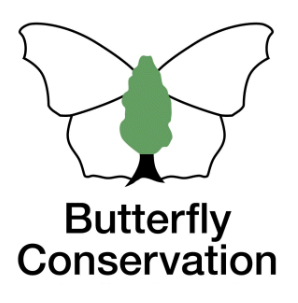Brown Argus
Brown Hairstreak
Chalkhill Blue
Clouded Yellow
Comma
Common Blue
Dark Green Fritillary
Dingy Skipper
Essex Skipper
Gatekeeper
Green Hairstreak
Green-veined White
Grizzled Skipper
Holly Blue
Large Skipper
Large White
Marbled White
Meadow Brown
Orange-tip
Painted Lady
Peacock
Purple Emperor
Purple Hairstreak
Red Admiral
Ringlet
Silver-washed Fritillary
Small Blue
Small Copper
Small Heath
Small Skipper
Small Tortoiseshell
Small White
Speckled Wood
Wall
White Admiral
White-letter Hairstreak
Extinct/rare immigrants
Small Copper
Lycaena phlaeas
General Distribution and Status
The Small Copper is widely distributed throughout Britain except on the mountains in north-west Scotland. It forms discrete colonies and not usually seen in any great numbers. The range has been stable over the last century although there have been many local extinctions caused by agricultural intensification (Heath et al.). Fortunately, sorrels, the larval foodplants, can grow on improved arable land even if populations of the butterfly in arable areas are often much lower. Its range has contracted slightly since 1976 and populations are declining too. The butterfly declined more dramatically in urban areas than in the countryside. From 1995 until 2014, its abundance fell by 75% in urban areas against 23% in rural areas (Dennis et al.). Numbers picked up again to a new peak in 2018 but generally dropped since then with the worst year on record in 2024. Sawford suggests that the Small Copper suffered more severe declines in Hertfordshire since the 1940s through habitat destruction coupled with the cooler summers in the 1960s mainly in the agricultural north-eastern parts of the county. Undoubtedly the warm summers of the mid 1990s boosted populations in Hertfordshire and Middlesex but after a period of a steep decline, populations strengthened remarkably in 2017 and 2018 but fell back in 2019 as elsewhere in the country although it has been reported in more places.
| United Kingdom | Herts & Middx | |||
| Distribution | 1976-2019 | -37% | 1980-2015 | +18% |
| Average 10-year trend | -8% | 2006-2015 | +31% | |
| 2024 since 2015-19 | +40% | |||
| Abundance | 1976-2024 | -44% | 1980-2015 | -71% |
| 2015-2024 | -5% | 2006-2015 | -36% | |
| 2023-2024 | -52% | 2024 since 2015-19 | -40% | |

UK distribution map
UKBMS Species summary
Habitat Requirements
The species occurs in a wide variety of habitats such as unimproved grassland, woodland rides, roadside verges and waste ground. It prefers sunny open situations containing bare patches and low-lying flowers. It may occasionally be found in gardens where the food-plant is present.
Larval Foodplants
Common Sorrel Rumex acetosa on chalky soils and Sheep's Sorrel Rumex acetosella on the more acidic soils. Other Dock Rumex spp. plants may also be used (Sawford).
Adult Food Sources
Common Ragwort Senecio jacobaea (140), Iceplant Sedum spectabile (55), Buddleia Buddleja davidii (52), Creeping Thistle Cirsium arvense (45), Heather Calluna vulgaris (42).
Historical Records
It seems that the Small Copper was a common butterfly at least since the Victorian era in Hertfordshire. Foster describes it as 'usually abundant'. However, Waterton in his 1970-81 report painted a worrying picture as the butterfly 'has decreased markedly over the last 20 years or so' probably mostly due to the cooler summers in the 1960s as already noted and the 1976 drought. Waterton also reports that 1933 was a great year with many aberrant forms taken.
Local Distribution and Abundance
As indicated on the map the Small Copper is widely distributed in the Stevenage area although there are no records from the TL22Z tetrad (north of Cromer) since 1995. Reasonable sized colonies can be found in Knebworth Park, near Watery Grove, Great Ashby Park and Frogmore Gravel Pit. The peak count of 23 was achieved at Knebworth Park on 17 August 2004. Inclement weather in the first half of 2024 impacted the butterfly's progress with only 54 specimens reported making the year the worst since 2016.

Stevenage (South Fairlands Valley Park) transect 1993-2025
The chart shows fluctuating fortunes for the Small Copper as a result of habitat changes although populations have stabilised in the last few years. Reflecting the situation elsewhere in the county, 1996 was a fantastic year yielding a total of 21, mostly in Canyon Field which has now completely overgrown. 2003 was a good year with numbers evenly split between the recently planted Millennium Wood and Shackledell Grassland but since 2007 no specimens have been found at the former. Millennium Wood was by then far too cool and overgrown for the butterfly to survive. 2018 proved to be the best year for the butterfly here since 1996 with six counted on 16 September at Shackledell Grassland and the adjoining grassland strip. Since 2018 however, the species is not surviving well and none were seen in 2021 and 2024.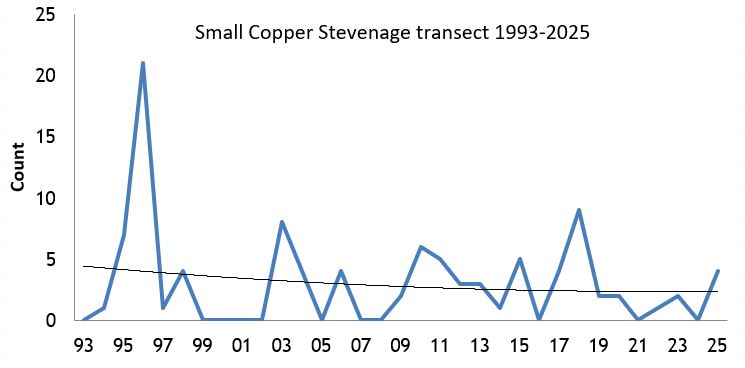

Knebworth Park transect 1996-2010 and 2017-2025
After the first two years numbers dropped alarmingly until the pick-up in the fine summer of 2003 but since then numbers have fallen again. However, since the survey was resumed in 2017 numbers have risen again with over 50 recorded in 2018 and 2020. The most favoured spots were in the meadow and fields north of Graffidge Wood and the north-western section of the park. As for the Stevenage transect, numbers significantly dropped in 2021 and only two seen in 2024 but rose markedly in 2025.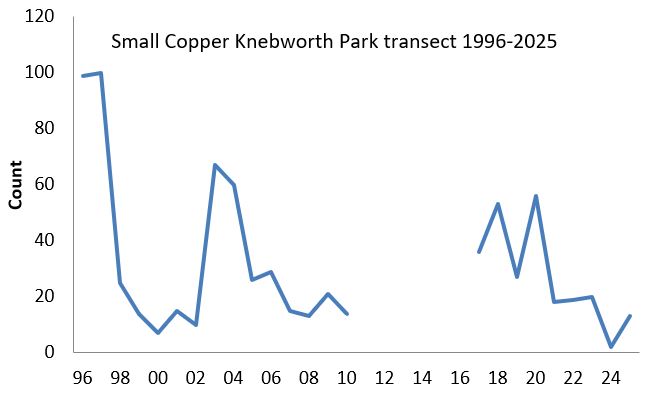
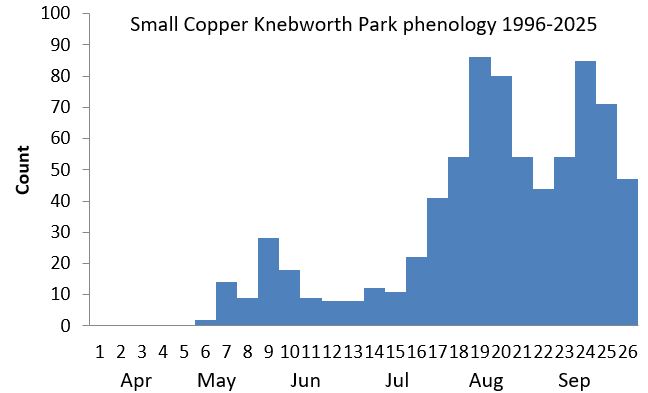
Knebworth Woods transect 2017-2025
2018 was the best year with ten sightings, all in the meadow at Norton Green Common and the extreme top end of the field beyond. Perhaps the drought in that year had an adverse effect on the sorrels, the larval foodplant and thereby producing fewer adults in 2019. A good recovery followed in 2020 but numbers continued to fall in subsequent years.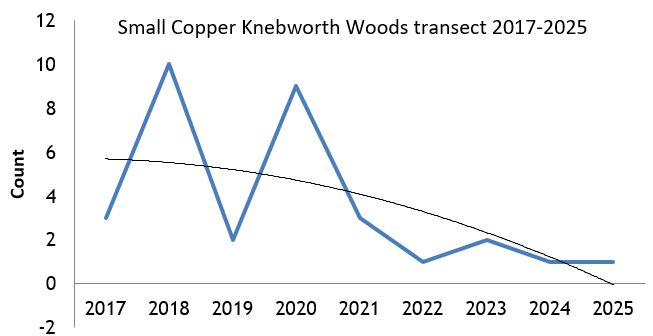
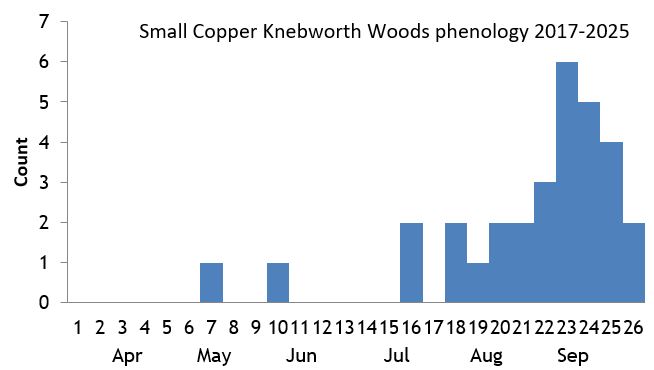
Pryor's Wood transect 2000-2022
There are no reports of this species.Life History
Earliest date: 19 April 2009 at Frogmore Gravel Pit
Latest date: 17 November 2018 at Watery Grove
There are normally
three generations a year with peaks in late May, first half of August, and September and early October. Very occasionally a partial fourth brood emerges
in November, for example on 17 November 2018 at Watery Grove. Four specimens were recorded on 25 October 2010 near the golf course off Old Knebworth Lane
which could relate to a fourth generation considering very few sightings were made in the previous 3 weeks. Eggs are
usually laid singly under a leaf of the foodplant, preferably in sunny locations. Larvae feed on the undersides of the leaves which form transparent grooves
when seen from above. The last generation of larvae hibernate until the following spring when pupae are formed low down in the vegetation.
Behaviour/Observation notes
The Small Copper is an active butterfly, particularly males who vigorously defend their territories close to the ground over bare patches. They often bask with their wings open and are easy to photograph if approached carefully. Females are less active as they spend much of their time feeding and activities associated with egg-laying. They are easy to spot feeding on daisies, their favourite nectar source.
Variations/Aberrations
Variations or aberrations are quite common on this butterfly. Probably the most likely aberration we will encounter in Hertfordshire
is ab. caeruleopunctata where there is a band of silvery-blue spots above the orange scalloped-band towards the edge of the hindwings. In my experience,
near Watery Grove, around 1 in 10 individuals are of this form. However, in the excellent summer of 2018, of at least 50 specimens, all in the Stevenage
area, of which I took photos, about half were of this aberration. One spectacular form ab. schmidtii where the copper colour is replaced by white is
well worth looking for.
Find out more on the UK Butterflies website
References

Watery Grove 22 Aug 2016 (m)

Knebworth Park 24 Sep 2017 (f)

Watery Grove 28 Sep 2017

ab. caeruleopunctata Watery Grove 7 Sep 2016

Egg Stevenage garden 5 Aug 2018

Larva Stevenage garden 5 Sep 2018
